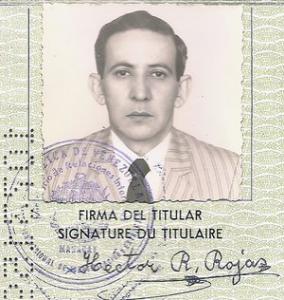NASA Brings Out The Lost Reports Of Hector R. Rojas, As Reported By Dr. Roja's Biographer
The reports contain the calculations to land on the Moon that guaranteed the safety of the astronauts of the Apollo 11 mission.
WASHINGTON, D.C., UNITED STATES, February 22, 2019 /EINPresswire.com/ -- The reports contain the calculations to land on the Moon that guaranteed the safety of the astronauts of the Apollo 11 mission and the success of the first manned lunar landing on Sunday, July 20, 1969.The National Aeronautics and Space Administration (NASA) has published recently inside the Server of its Scientific and Technical Information Program, the first three studies conducted by the Venezuelan astrophysicist Hector R. Rojas, between August 1966 and February 1967, as part of his job in the Apollo Lunar Program. These scientific studies contain the calculations for the landing of the Apollo 11 mission on the surface of the Moon. This year will be the 50th commemoration of this historical milestone, which was the arrival of the human being to the Moon on July 20, 1969.
The biographer of Dr. Hector R. Rojas, astrophysicist for the University of Paris, has been the manager of spreading the news. The Spanish-Venezuelan professor and writer Pierre Monteagudo explained that he had previously received a communication from the technical and scientific management office of NASA, indicating that once the documentation issued by the Johnson Space Center, of Houston, Texas, was obtained, they proceeded they proceeded to publish the three studies written by Dr. Rojas in the Technical Report Server, which are available to the public from Wednesday, February 20, 2019. The NASA Technical Reports Server (NTRS) contains all the scientific studies created or sponsored by NASA since 1958, but interestingly, the reports prepared by Hector R. Rojas were missing. They have had to spend more than 50 years so that finally, the full text of the three documents is now available in pdf format that can be viewed and downloaded by any interested person.
The first report published on December 1st, 1966, is the mathematical technique created by the astrophysicist Hector R. Rojas and contains a series of spatial coefficients that helped him collect data from the surface of the Moon that he later used to calculate, with mathematical precision, the optimal lunar area for the landing of manned ships. Through the successive transformations of his own method, Dr. Rojas was able to determine the temperature that the astronauts would find in the equatorial region of the Moon, when they disembarked on its surface. The scientist used extrapolation to obtain a temperature distribution, known in NASA as “Contours of Rojas” which is expressed in the second report, published on February 1th, 1967. In this way, he was able to demonstrate that the surface temperature of the satellite was related to the lunar topography, since there were different readings in craters, hillsides and plains. This is how Dr. Rojas prepared a map of the topography and relief of the Moon much more accurately than that obtained only with images. In the third report, published in July 1967, the astrophysicist presented a detailed analysis of the composition of the Moon and the amount of sunlight reflected by the lunar surface, based on observations made from Earth and the analysis of the images taken by the automated space probes of the Surveyor and Lunar Orbiter series, which orbited the Moon, before sending the manned missions. The three NASA studies were originally published by the Manned Spacecraft Center (MSC) in Houston, Texas.
The set of investigations that were carried out allowed Hector R. Rojas to study in detail the areas of the lunar surface, with less roughness, where the Apollo missions finally landed.
Other studies of this author to NASA that are pending publication in the Server of Technical and Scientific Reports are:
•Report 4, published in 1968, with the title: Third Application of the Successive Transformation Method. For the analysis of the Surveyor and Lunar Orbiter photographs, written by Hector R. Rojas, Ph. D., for NASA - Manned Spacecraft Center (MSC). Due to its enormous importance, this study was translated into French and sent to scientists and institutions in France by the United States Senate Committee on Aeronautical and Space Sciences.
•Study of the Radiation of Microwaves in the Atmosphere of Venus, published by NASA, in 1968, from the work done by Dr. Rojas, at the Institute of Technological Research of Illinois, in Chicago.
All the work done for years by Pierre Monteagudo, to achieve the recognition of Hector R. Rojas as the author of NASA reports, is part of a process of global claim of the genius and figure of the astrophysicist and constitutes a tribute to his posthumous memory, which consolidates with the recovery of its scientific legacy, through the publications made by NASA. All the available information about this scientist can be read in the book, "The Rojas File".
Pierre Monteagudo
Scientific Writer
674 59 68 94
email us here
Legal Disclaimer:
EIN Presswire provides this news content "as is" without warranty of any kind. We do not accept any responsibility or liability for the accuracy, content, images, videos, licenses, completeness, legality, or reliability of the information contained in this article. If you have any complaints or copyright issues related to this article, kindly contact the author above.

